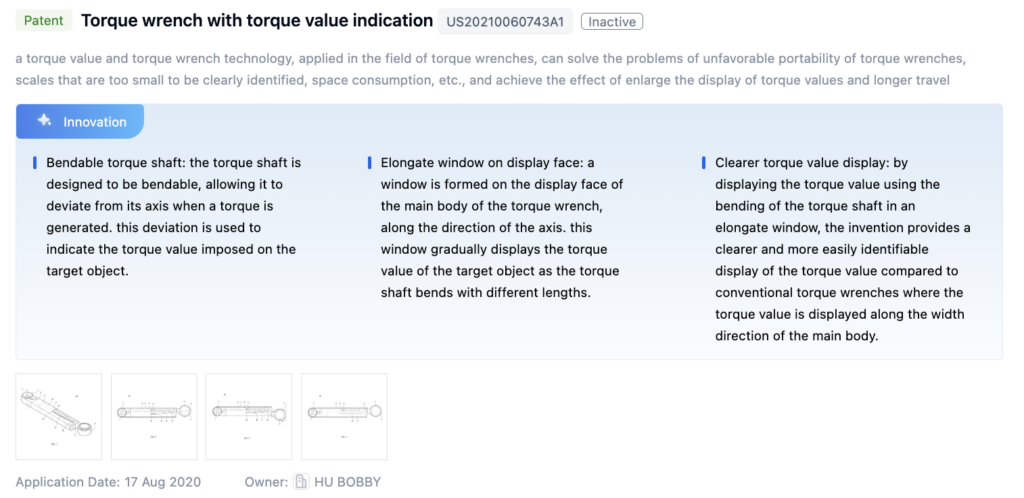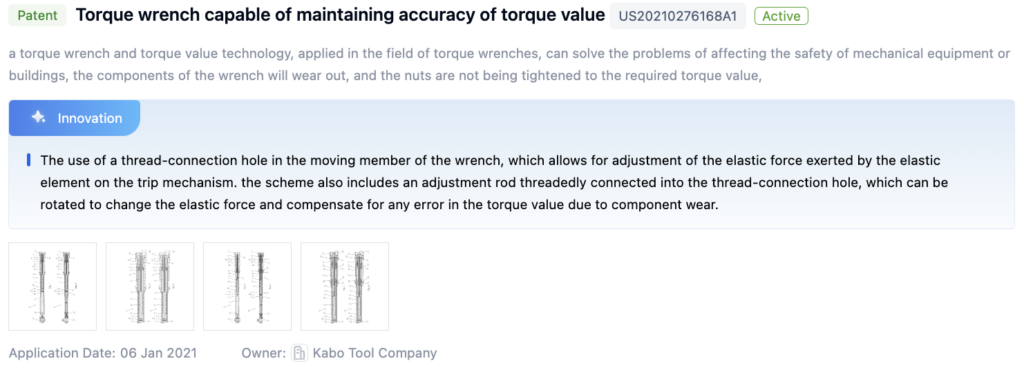
Torque Wrench Technology Background and Goals
A torque wrench is an essential tool used in various industries such as automotive, aerospace, and construction to ensure proper tightening of fasteners. The torque performance of these wrenches is crucial for maintaining the integrity of assembled components and preventing potential failures. The primary goal of this research is to enhance the torque performance of torque wrenches while maintaining a simple and cost-effective design.
This includes investigating new materials, mechanisms, and manufacturing techniques to improve accuracy, repeatability, and durability without adding unnecessary complexity or cost. The objective is to develop torque wrenches that can consistently deliver precise torque values across a wide range of applications, from delicate precision assemblies to heavy-duty industrial settings. Additionally, the research aims to address challenges related to ergonomics, ease of use, and maintenance, ensuring that the improved torque wrenches are user-friendly and efficient in various working environments. Extending the service life of torque wrenches by developing robust designs, using wear-resistant materials, and implementing self-diagnostic features is also a key goal.

To get detailed scientific explanations of torque wrenches, try Patsnap Eureka TechResearch.
Market Demand for High-Performance Torque Wrenches
The market demand for high-performance torque wrenches is driven by the need for precision and reliability in industries such as automotive, aerospace, construction, manufacturing, and oil and gas. In these industries, torque wrenches are essential for ensuring proper tightening of critical components, which is crucial for safety, product quality, and operational efficiency.
As industries strive for higher quality standards and improved safety, the demand for accurate and durable torque wrenches continues to grow. The aerospace industry, in particular, has stringent requirements for torque control due to the critical nature of aircraft components. Similarly, in the automotive industry, improper torque application can lead to safety issues and potential failures. In construction and manufacturing, torque wrenches must withstand harsh environments and provide consistent torque application over extended periods. The oil and gas industry also requires torque wrenches that can perform reliably under extreme conditions.
Current State and Challenges of Torque Wrench Technology

Torque wrenches are essential tools in various industries where precise and controlled tightening of fasteners is crucial. However, the current state of torque wrench technology faces several challenges:
- Complexity of Designs: Many torque wrenches have intricate mechanisms with numerous moving parts, making them prone to wear and tear and potentially compromising their accuracy over time.
- Trade-off Between Accuracy and Ease of Use: Highly accurate torque wrenches often require specialized training and careful handling, while simpler wrenches may sacrifice accuracy for ease of use.
- Durability Issues: Exposure to harsh environments, such as extreme temperatures and moisture, can adversely affect the performance and longevity of torque wrenches.
- Geographical Distribution: Advanced torque wrench designs and manufacturing capabilities are concentrated in developed regions, limiting access in emerging markets.
Evolution of Torque Wrench Technologies

Existing Solutions for Enhancing Torque Performance
Torque Wrench Structure and Components
The structure and components of the torque wrench, including the handle, drive head, and torque adjustment mechanism, play a crucial role in its performance. Various designs are employed to ensure precise torque application and measurement.
Torque Adjustment and Calibration
Torque wrenches often feature mechanisms for adjusting and calibrating the desired torque value. Proper calibration is essential for maintaining the wrench’s torque performance over time.
Torque Indication and Feedback
Torque wrenches may incorporate visual indicators, audible signals, or electronic displays to indicate the applied torque. Accurate indication helps users apply the correct torque and avoid over-tightening or under-tightening.
Torque Limiting and Overload Protection
Some torque wrenches feature torque limiting mechanisms or overload protection systems to prevent excessive torque application, protecting the workpiece and the wrench.
Specialized Torque Wrench Designs
Specialized designs, such as hydraulic or electric torque wrenches, are tailored for specific applications or environments, enhancing performance and usability.
Key Players in Torque Wrench Industry
Hangzhou Perine Tools Co. Ltd.
- Developed a torque wrench with an enhanced ratchet mechanism that reduces friction and increases the efficiency of torque transfer.
Kabo Tool Company
- Offers a torque wrench with a unique gear design that enhances torque output while maintaining a simple structure.
Valeo Kapec Co. Ltd.
- Introduced a torque wrench with an advanced clutch mechanism that ensures consistent torque delivery.
Sichuan University
- Conducted research on a torque wrench with a spring-loaded mechanism that provides a uniform torque output.
Hangzhou Xinmai Technology Co. Ltd.
- Developed a torque wrench with an innovative hydraulic system for precise torque adjustments.
Core Innovations in Torque Wrench Design
Patent 1: Torque Wrench with Torque Value Indication
- Bendable Torque Shaft: The torque shaft deviates from its axis when torque is applied, indicating the torque value.
- Elongate Window on Display Face: A window on the wrench displays the torque value as the shaft bends.
- Clearer Torque Value Display: The design provides a clearer and more easily identifiable torque value display.

Patent 2: Torque Wrench Capable of Maintaining Accuracy
- Thread-Connection Hole in Moving Member: Allows adjustment of the elastic force exerted by the elastic element on the trip mechanism, compensating for component wear.

Paper 1: Wireless Torque and Power Transfer
- Evaluation of 13 Wrench Systems: The study found that beam wrenches showed lower deviations from preset values compared to coil and toggle-style wrenches.

Potential Breakthroughs in Torque Wrench Performance
- Adjustable Torque Settings: Allows for easy and quick adjustment of the torque setting.
- Torque Indication or Feedback: Provides visual or audible feedback when the desired torque value is reached.
- Overload Protection: Prevents excessive torque application, protecting the tool and workpiece.
- Electric or Powered Torque Wrenches: Provide easier and more consistent torque application.
- Calibration and Evaluation: Techniques and devices ensure accurate and consistent torque performance.
Regulatory Landscape for Torque Wrench Manufacturing
Key Standards:
- ISO 6789 and ISO 6789-2: Design, performance, and testing requirements for torque wrenches.
- OSHA Guidelines: Safe use and maintenance of torque wrenches in industrial settings.
- RoHS and REACH: Regulate the use of hazardous materials in production.
Compliance:
- Adhering to these standards ensures product safety, quality, and environmental responsibility, enhancing brand reputation and customer trust.
Environmental Impact of Torque Wrench Production
Environmental Concerns:
- Raw Material Extraction: Leads to resource depletion and environmental degradation.
- Energy Consumption: Manufacturing processes contribute to greenhouse gas emissions.
- Waste Generation: Includes metal shavings, plastic scraps, and hazardous materials.
Mitigation Strategies:
- Use of Recycled Materials: Reduces demand for virgin resources.
- Energy-Efficient Processes: Lowers carbon footprint.
- Effective Waste Management: Recycling and responsible disposal of hazardous materials.
By addressing these aspects and continuously innovating, torque wrench technology can significantly improve, leading to more efficient, reliable, and environmentally sustainable tools for various industries.
If you want in-depth research or a technical report, you can always get what you want in Patsnap Eureka TechResearch. Try now!

